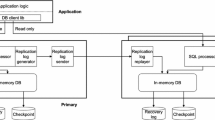Abstract
The importance of reporting is ever increasing in today’s fast-paced market environments and the availability of up-to-date information for reporting has become indispensable. Current reporting systems are separated from the online transaction processing systems (OLTP) with periodic updates pushed in. A pre-defined and aggregated subset of the OLTP data, however, does not provide the flexibility, detail, and timeliness needed for today’s operational reporting. As technology advances, this separation has to be re-evaluated and means to study and evaluate new trends in data storage management have to be provided. This article proposes a benchmark for combined OLTP and operational reporting, providing means to evaluate the performance of enterprise data management systems for mixed workloads of OLTP and operational reporting queries. Such systems offer up-to-date information and the flexibility of the entire data set for reporting. We describe how the benchmark provokes the conflicts that are the reason for separating the two workloads on different systems. In this article, we introduce the concepts, logical data schema, transactions and queries of the benchmark, which are entirely based on the original data sets and real workloads of existing, globally operating enterprises.





Similar content being viewed by others
References
Astrahan, M. M., Blasgen, M. W., Chamberlin, D. D., Eswaran, K. P., Gray, J. N., Griffiths, P. P., et al. (1976). System R: Relational approach to database management. TODS ’76: ACM Transactions on Database Systems, 1(2), 97–137.
Cecchet, E., Candea, G., & Ailamaki, A. (2008). Middleware-based database replication: The gaps between theory and practice. In SIGMOD ’08: Proceedings of the 2008 ACM SIGMOD international conference on management of data (pp. 739–752). New York: ACM.
Chmura, A., & Heumann, J. M. (2005). Logical data modeling: What it is and how to do it. Springer.
Codd, E. F. (1970). A relational model of data for large shared data banks. Communications of the ACM, 13(6), 377–387.
Colohan, C. B., Ailamaki, A., Steffan, J. G., & Mowry, T. C. (2008). Incrementally parallelizing database transactions with thread-level speculation. ACM Transactions Computer Systems (TOCS), 26(1), 1–50.
Dayal, U., Kuno, H., Wiener, J. L., Wilkinson, K., Ganapathi, A., & Krompass, S. (2009). Managing operational business intelligence workloads. SIGOPS Operating Systems Review, 43(1), 92–98.
French, C. D. (1997). Teaching an OLTP database kernel advanced data warehousing techniques. In ICDE ’97: Proceedings of the thirteenth international conference on data engineering (pp. 194–198). Washington, DC: IEEE Computer Society.
Frolick, M., & Ariyachandra, T. R. (2006). Business performance management: One truth. Information Systems Management, 23(1), 41–48.
Han, J., & Kamber, M. (2001). Data mining: Concepts and techniques. Morgan Kaufmann.
Hsu, W. W., Smith, A. J., & Young, H. C. (1999). Analysis of the characteristics of production database workloads and comparison with the TPC benchmarks. Technical report, Berkeley, CA, USA.
Inmon, W. H. (1996). Building the data warehouse (2nd ed.). New York: Wiley.
Inmon, W. H. (1999). Building the operational data store. New York: Wiley.
Inmon, W. H. (2000). Operational and informational reporting: Information management: Charting the course. DM Review Magazine, July.
O’Neil, P. E., O’Neil, E. J., & Chen, X. (2007). The Star Schema Benchmark (SSB). http://www.cs.umb.edu/~poneil/StarSchemaB.pdf. Accessed 2 March 2009.
Othayoth, R., & Poess, M. (2006). The making of TPC-DS. In VLDB ’06: Proceedings of the 32nd international conference on very large databases (pp. 1049–1058). VLDB Endowment.
Poess, M., Nambiar, R. O., & Walrath, D. (2007). Why you should run TPC-DS: A workload analysis. In VLDB’07: Proceedings of the 33rd international conference on very large data bases (pp. 1138–1149). Vienna: VLDB Endowment.
Poess, M., Smith, B., Kollar, L., & Larson, P. (2002). TPC-DS, taking decision support benchmarking to the next level. In SIGMOD ’02: Proceedings of the 2002 ACM SIGMOD international conference on management of data (pp. 582–587). New York: ACM.
Schaffner, J., Bog, A., Krueger, J., & Zeier, A. (2008). A hybrid row-column OLTP database architecture for operational reporting. In BIRTE ’08: Proceedings of the second international workshop on business intelligence for the real-time enterprise, in conjunction with VLDB’08, August 24, 2008. Auckland, New Zealand.
Stonebraker, M., Abadi, D. J., Batkin, A., Chen, X., Cherniack, M., et al. (2005). C-store: A column-oriented DBMS. In VLDB ’05: Proceedings of the 31st international conference on very large databases ( pp. 553–564). VLDB Endowment.
TPC (2007a). TPC benchmark C, standard specification, revision 5.9. Technical report, Transaction Processing Performance Council.
TPC (2007b). TPC benchmark DS, standard specification, version 1.0.0d. Technical report, Transaction Processing Performance Council.
TPC (2008a). TPC benchmark E, standard specification, version 1.5.1. Technical report, Transaction Processing Performance Council.
TPC (2008b). TPC benchmark H (decision support), standard specification, revision 2.7.0. Technical report, Transaction Processing Performance Council.
Vieira, M., & Madeira, H. (2003). A dependability benchmark for OLTP application environments. In VLDB’03: Proceedings of the 29th international conference on very large databases (pp. 742–753). VLDB Endowment.
White, C. (2006). The next generation of business intelligence: Operational BI. Whitepaper, BI Research, Sybase, July.
Author information
Authors and Affiliations
Corresponding author
Rights and permissions
About this article
Cite this article
Bog, A., Plattner, H. & Zeier, A. A mixed transaction processing and operational reporting benchmark. Inf Syst Front 13, 321–335 (2011). https://doi.org/10.1007/s10796-010-9283-8
Published:
Issue Date:
DOI: https://doi.org/10.1007/s10796-010-9283-8




